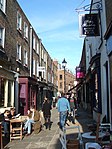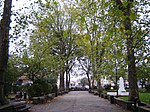Business Design Centre

The Business Design Centre is a Grade II listed building located between Upper Street and Liverpool Road in the district of Islington in London, England. It was opened in 1862, originally named the Agricultural Hall and from 1884 the Royal Agricultural Hall, for holding agricultural shows. It was the home of the Royal Smithfield Club's Smithfield Show from 1862 to 1938. It hosted the Royal Tournament from its inauguration in 1880 until the event became too large for the venue and moved to Olympia in the early years of the 20th century. It hosted the first Crufts dog show in 1891. During the Second World War, the hall was commandeered by the Government, and from 1943, following the destruction of Mount Pleasant sorting office in an air raid, the parcels depot was moved to the hall. The hall then remained unused and empty until it was converted to its present use as the Business Design Centre in 1986.
Excerpt from the Wikipedia article Business Design Centre (License: CC BY-SA 3.0, Authors, Images).Business Design Centre
Upper Street, London Clerkenwell (London Borough of Islington)
Geographical coordinates (GPS) Address External links Nearby Places Show on map
Geographical coordinates (GPS)
| Latitude | Longitude |
|---|---|
| N 51.535582 ° | E -0.105688 ° |
Address
Business Design Centre
Upper Street 52
N1 0QH London, Clerkenwell (London Borough of Islington)
England, United Kingdom
Open on Google Maps











